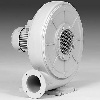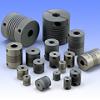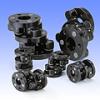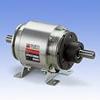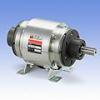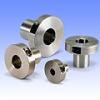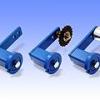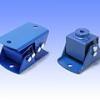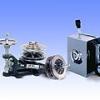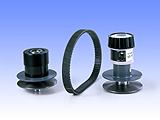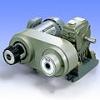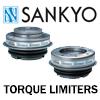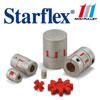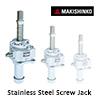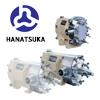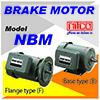สินค้าขายดี (132)
The 121-[]-20 type has a open-type through shaft structure. The power is applied from the input hub, and is output constantly from the output shaft. Braking of output shaft is performed by the energization of brake in response to the current interruption of clutch. It is strongly resistant to a radial load with a wide bearing span that it can be used with high tension by mounting a V pulley or spur gear. Due to the through-shaft construction, both sides of the shaft can be used for output. Mechanism layout such as using both sides for branch drive, or mounting a detection disc to one side can be performed.
121-[]-10 Type (Double clutch)It is a double clutch unit with two clutches set on the both side of drum sharing basic design with clutch-brake unit 121-[]-20. Two-stage speed change and forward-reverse operation with hub input, or distribution of motive power with shaft input can be selected. As well as 121-[]-20, it is strongly resistant to a radial load with a wide bearing span that it can be used with high tension by mounting a V pulley or spur gear.
BXL Model (Braking)The BXL model is a compact brake exclusively for braking. An asbestos-free special friction material with a high resistance to wear is used to endure use for a long time. Torque fluctuation is small. Load is braked instantaneously even in trouble. A rotor spring reduces a rasping high-frequency friction sound during braking. A quiet braking sound is ensured.
546 Model (Toothed clutch)Torque is transmitted by engagement of teeth and large torque can be transmitted even though the clutch is small. There are full position with entire circumference engagement and single position with fixed position engagement (engaged at one position in one revolution). As a tooth tip configuration, full depth tooth usable in any rotation direction and saw tooth with higher relative velocity engagement are available.
Only one pressure screw allows easy and quick mounting and dismounting. A pressure medium sealed inside of the chamber is pressurized by fastening the pressure screw, and moves equally into the sleeve. By the pressurization of a pressure medium, the sleeve is pressured from inside to contract the shaft-sided sleeve and enlarge the hub-sided sleeve to fasten a shaft and hub through the sleeve. Since the ETP-TECHNO uses only one pressure screw to fasten, assembling time of equipment requiring a positioning can be substantially reduced. It is also useful for the place requiring a repetitive mounting and dismounting. Furthermore, a high-precision mounting and ultrahigh-precision positioning can be performed due to its excellent concentricity of 0.006 mm. A simple anti-rust specification with electroless nickel plating (ETP-T-C) is also available.
ETP-T TypeOnly one pressure screw allows easy and quick mounting and dismounting. A pressure medium sealed inside of the chamber is pressurized by fastening the pressure screw, and moves equally into the sleeve. By the pressurization of a pressure medium, the sleeve is pressured from inside to contract the shaft-sided sleeve and enlarge the hub-sided sleeve to fasten a shaft and hub through the sleeve. Since the ETP-TECHNO uses only one pressure screw to fasten, assembling time of equipment requiring a positioning can be substantially reduced. It is also useful for the place requiring a repetitive mounting and dismounting. Furthermore, a high-precision mounting and ultrahigh-precision positioning can be performed due to its excellent concentricity of 0.006mm. The standard ETP-T type is a steel specification.
ETP-T-C TypeOnly one pressure screw allows easy and quick mounting and dismounting. A pressure medium sealed inside of the chamber is pressurized by fastening the pressure screw, and moves equally into the sleeve. By the pressurization of a pressure medium, the sleeve is pressured from inside to contract the shaft-sided sleeve and enlarge the hub-sided sleeve to fasten a shaft and hub through the sleeve. Since the ETP-TECHNO uses only one pressure screw to fasten, assembling time of equipment requiring a positioning can be substantially reduced. It is also useful for the place requiring a repetitive mounting and dismounting. Furthermore, a high-precision mounting and ultrahigh-precision positioning can be performed due to its excellent concentricity of 0.006mm. The ETP-T-C type is a simple anti-rust specification with electroless nickel plating.
The clamping bolts placed on the flange surface allow easy and quick mounting and dismounting. A pressure medium sealed inside of the sleeve is compressed by fastening the clamping bolt. By the compression of a pressure medium, the sleeve is pressured from inside to contract the shaft-side sleeve and enlarge the hub-side sleeve to fasten a shaft and hub through the sleeve. Compared with a mechanical-type fastening element, the number of bolts to be used is small. Also, a high-precision fastening is possible with no slotting. A large variety of specifications such as hexagon bolt, simple antirust with electroless nickel plating, stainless steel or short sleeve specification are available.
In a word, this product is a shock absorber. The ROSTA is a multifunction and multipurpose product with a unique principle and construction. Three functions, spring, damper and bearing functions, are provided at the same time. It is composed of a metal inner shell, outer shell with 45 deg. of displacement and precompressed cylindrical rubber. In addition to a tensioner, it can be used as a rocking, vibration-proofing equipment or suspension of all industrial machinery based on this suspension unit.
It can be used as tensioners, pressure rollers or dampers by attaching an arm to the ROSTA suspension unit to set a roller or sprocket. The outer shell has a flange shape and can be mounted using only one center bolt. The mounting hole of idlers can be selected depending on the load range (normal/hard) . The SE model with no idler, the belt tensioner RSE model with idler and the NSE model with sprocket idler are available
The vibration isolation mount ROSTA is effective in vibration control for all kinds of machinery. The ESL model corresponding to an intermediate frequency range of eigenfrequency 4.5 to 11Hz and the V model corresponding to a relatively higher frequency range are available. Both models correspond to any mounting direction, also left, light, top, bottom, back and front loading direction.
Intermediate Pulley(L,U,T Model)An intermediate-type variable speed drive is a speed change pulley used between the motor and machine. Two fixed pulleys (cone) are set at both ends of the sleeve and a moving pulley (cone) is set between them. Speed is changed by moving the pulley to the thrust direction to change the pitch diameters of the motor-side and the machine-side intermediate pulleys antagonistically. The L model with lever-operated speed change, U model with handle-operated speed change and T model for user-defined design are available.
When turning the handle of the motor-side speed changer, the width of the speed change pulley will change. By varying the pitch diameter of the speed change belt, the pitch diameter of the machine-side speed change pulley will follow to change the rotation speed. The PDS model is a belt-type stepless speed change drive that is incorporated directly into machines to save space. There are 6 sizes from 0.2kW to 3.7kW (4-pole) of transmission capacity.
PDG ModelThe PDG model is a non-stage speed change unit combining a speed changer of the PDS model, motor and worm reducer on the bed. Various applications such as changing the motor to a brake motor, setting the reducer output shaft upward or using a two-speed worm reducer are available except the standard PDG-BSN model. For the PDG-BSN model, the motor output of 0.2kW to 3.7kW (4-pole) and the reducer rate of 1/10 to 1/60 are available.
SFC ModelThe SFC model is a metal disk type coupling with lightweight and high-strength aluminum alloy used for the clamp hub. It has a high torsional rigidity and responsiveness. The SFC-SA2 with single element and ultrahigh rigidity and the SFC-DA2 with double elements and flexibility are available. Each type has a green design corresponding to the RoHS.
SFS Model
The SFS model are metal disk type couplings. Carbon steel is used for the body material. Very high torsional rigidity assures accurate shaft rotation and ultra precision control. A single element type with high rigidity, double-element type with flexibility (two elements are used through a spacer plate) and floating type with a flange between double elements are available. Assembly finished or partly-finished product, frictional fastening or key fastening of shaft, or taper shaft correspondence is available for each type.






